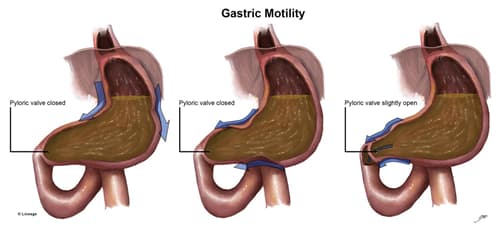Overview

- Gastric motility
- functions
- orad stomach relaxes to receive the food bolus from the esophagus
- orad stomach = fundus and proximal body
- caudad stomach contractions reduce size of the food bolus and mix it with gastric secretions to initiate digestion
- caudad stomach = distal body and antrum
- gastric emptying propels the chyme into the duodenum of small intestines
- orad stomach relaxes to receive the food bolus from the esophagus
- receptive relaxation
- distension of the lower esophagus by the food bolus produces relaxation and opening of the lower esophageal (cardiac) sphincter and, simultaneously, relaxation of the orad stomach
- reduces pressure and increases volume of the orad stomach
- vagovagal reflex
- both afferent and efferent limbs of reflex are carried in the vagus nerve
- afferent fibers deliver sensory information from the periphery to the CNS
- mechanoreceptors detect distension of the lower esophagus and the orad stomach by the food bolus and relay sensory information to the CNS via afferent fibers of the vagus nerve
- efferent fibers deliver motor information from the CNS to the periphery
- CNS relays motor information to the smooth muscle walls of the lower esophagus and the orad stomach via efferent fibers of the vagus nerve
- postganglionic peptidergic vagal efferent fibers release vasoactive intestinal polypeptide (VIP), which relaxes the lower esophageal (cardiac) sphincter and smooth muscle of the orad stomach
- CNS relays motor information to the smooth muscle walls of the lower esophagus and the orad stomach via efferent fibers of the vagus nerve
- distension of the lower esophagus by the food bolus produces relaxation and opening of the lower esophageal (cardiac) sphincter and, simultaneously, relaxation of the orad stomach
- mixing and digestion
- caudad stomach has a thick muscular wall
- produces contractions necessary for fragmenting and mixing food
- contractions mix gastric contents and propel contents from the antrum of stomach back into the body of the stomach (“retropulsion”)
- retropulsion further fragments and mixes gastric contents
- caudad stomach has a thick muscular wall
- gastric emptying
- contractions periodically propel a portion of the gastric contents through the pylorus and pyloric sphincter into the duodenum of the small intestine
- gastric emptying is closely regulated to allow adequate time for neutralization of gastric acid in the duodenum and adequate time for digestion and absorption
- H+ receptors in the duodenum detect low pH (high H+) and act via interneurons in the myenteric (Auerbach’s) nerve plexus to slow gastric emptying
- ↓ gastric emptying ensures gastric contents are delivered slowly to the duodenum
- allows adequate time for neutralization of gastric acid in the duodenum by pancreatic HCO3–
- necessary for optimal function of pancreatic enzymes
- allows adequate time for neutralization of gastric acid in the duodenum by pancreatic HCO3–
- ↓ gastric emptying ensures gastric contents are delivered slowly to the duodenum
- arrival of fatty acids in the duodenum stimulates cholecystokinin (CCK) secretion by I cells in the small intestine to slow gastric emptying
- ↓ gastric emptying ensures gastric contents are delivered slowly to the duodenum
- allows adequate time for fatty acid digestion and absorption in the small intestine
- ↓ gastric emptying ensures gastric contents are delivered slowly to the duodenum
- H+ receptors in the duodenum detect low pH (high H+) and act via interneurons in the myenteric (Auerbach’s) nerve plexus to slow gastric emptying
- functions



